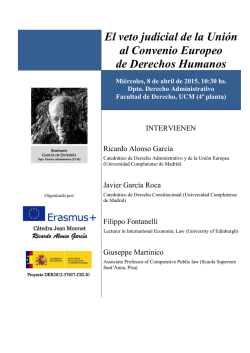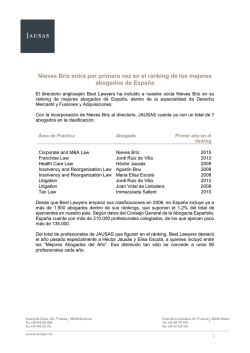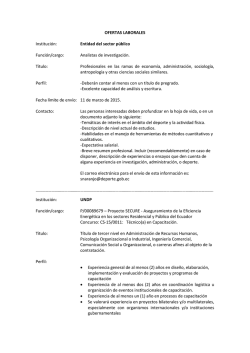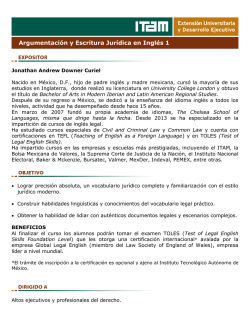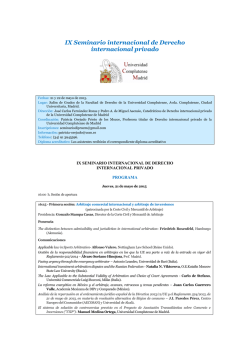
descargar - Estudio Pereira & Asociados, especialistas en Media
CPO FDD 2015 9 de marzo de 2015 ETICA JURIDICA COM. 1859 · Luciano F. Pereira Los abogados, insertos en la lógica de procesos adversariales, deben continuamente dar respuesta a dilemas éticos concretos y muchas veces diferentes de los que pueden presentarse a los legisladores, soberanos y jueces. Tradicionalmente, la Filosofía del Derecho no siempre les ha prestado debida atención a los operadores elementales del quehacer jurídico que tienen a su cargo la tarea de lealmente representar profesionalmente a un cliente y “no deciden nada” y a menudo se encuentran en situaciones que sus intereses y objetivos pueden divergir de los de sus representados. Pero su labor trasciende lo individual, si bien dentro del sistema legal su rol no es la búsqueda directa e imparcial de “la justicia”, la garantiza, al asumir la dirección técnica en la preparación del procedimiento y la consecución de los medios de Programa del Curso Como indica M. La Torre, el iuspositivismo ha estado obsesionado por el momento de la decisión. Sin decisión no hay derecho y desde luego, el abogado a su pesar, no decide nada 1 CPO FDD 2015 9 de marzo de 2015 prueba, asegura la contradicción y el ejercicio del derecho de defensa.¿Qué particularidades de los sistemas legales explican, justifican y condicionan las acciones de los abogados y hacen necesarios estándares éticos? ¿Qué compromisos y rasgos de conducta típicos son los esperados para los futuros profesionales por parte de los Códigos de Ética? ¿Cuáles son los desafíos del abogado ante las nuevas formas de ejercer la profesión dentro de una sociedad en transformación? Estos temas son de especial interés para el futuro abogado en formación siendo una perspectiva válida de abordaje. El dotar al alumno con los contenidos filosóficos necesarios contribuye a la reflexión de su rol profesional de cara a sus futuros clientes, el servicio de justicia y rol en la sociedad. B. OBJETIVOS • Reconocer y Describir los problemas éticos de la profesión de abogado. • Analizar los efectos prácticos de las normas éticas de la materia. • Examinar el funcionamiento, detectar conflictos y condicionamientos de la labor profesional. Según las distintas áreas de desempeño de los abogados. • Evaluar las consecuencias de las decisiones profesionales C. METODOLOGÍA El objetivo principal del curso es poder identificar, analizar y enfrentar dilemas reales y simulados vinculados con la futura profesión Se emplearán técnicas activas y participativas. En particular Técnicas Didácticas ABP · Aprendizaje Basado en Problemas · fomentando el desarrollo de habilidades, capacidades y competencias sustentadas en cuerpos de conocimiento multidisciplinario. A partir de la identificación, análisis, enfrentamiento y solución sistemática de dilemas reales y simulados vinculados con la futura profesión se exploran las capacidades y competencias profesionales necesarias que el futuro abogado debe cultivar, tratando de despertar el interés del alumno en la temática y su participación activa, lectura, discusión y análisis, fortaleciendo la formación de un pensamiento creativo y crítico. En función de ello podrán proponerse tareas suplementarias. Programa del Curso 2 CPO FDD 2015 9 de marzo de 2015 ETICA JURIDICA & ABOGACÍA PROGRAMA INTRODUCCION - CONCEPTOS FUNDAMENTALES Moral Positiva, Moralidad y Etica. Argumentación y Conocimiento Moral. Teorías Deontológicas y Teleológicas. PRINCIPIOS GENERALES. DEBERES ESENCIALES. 1. LA FUNCION DEL ABOGADO EN LA SOCIEDAD: 1.a. Breve reseña histórica: De Roma al Sistema Cravath 1.b. Examen empírico de las condiciones sociales y políticas 1.c. validez jurídica y eficacia 1.d. El Abogado como operador jurídico 1.e. Las profesiones Jurídicas 1.f. Características de las profesiones liberales 1.g. El Rol Actual del Abogado 1.g.(1) El Abogado Independiente 1.g.(2) El Abogado Corporativo 1.g.(3) El Abogado Interno 1.g.(4) El Abogado de la Administración Pública 1.h. Sociedad y Gestión del Conflicto. 1.i. Nuevas Funciones del Derecho. 1.j. Principios de Actuación 2. PRINCIPIOS GENERALES y DEBERES ESENCIALES: 2.a. INDEPENDENCIA 2.a.(1) Interna 2.a.(2) Externa 2.a.(3) Normas Deontológicas 2.b. CONFIANZA e INTEGRIDAD 2.b.(1) Confiabilidad 2.c. SECRETO PROFESIONAL 2.d. INCOMPATIBILIDADES 2.e. PUBLICIDAD PERSONAL 2.e.(1) Prospección 2.e.(2) Problemas de Agencia 2.e.(3) Asesoramiento 2.e.(4) Demandas Frívolas 2.(6) Intereses del Cliente Programa del Curso 3 CPO FDD 2015 9 de marzo de 2015 ETICA JURIDICA & ABOGACÍA 3. RELACIONES CON LOS CLIENTES 3.a. Comienzo y Fin de la relación. 3.b. Grados de representación. 3.c. Diligencia. 3.c.(1) Tiempos de respuesta 3.c.(2) Comunicaciones 3.d. Conflicto de Intereses 3.d.(1) Introducción 3.d.(2) Cliente “directo adverso” 3.d.(3) Representación materialmente limitada. 3.d.(4) Negocios Directos 3.d.(5) Confidencialidad 3.d.(6) Relaciones Personales 3.d.(7) Conflicto de empleadores 3.d.(8) La empresa como cliente 3.e. Quota Litis. Honorarios y Provisión de Fondos 3.e.(1) Responsabilidad Profesional. 3.e.(2) Actividad Pro Bono. 4. RELACIONES ENTRE ABOGADOS 4.a. 4.b. 4.c. 4.d. 4.e. 4.f. 5. RELACIONES EN Y ANTE LOS TRIBUNALES 5.a. 5.b. 5.c. 5.d. 6. Cooperación Correspondencia Clientela Conflictos Riesgo Moral y problemas de agencia Trabajo extrajudicial y los procesos no adversariales. Conducta en el proceso Conducta ante los tribunales Informaciones Falsas o Susceptibles de inducir a error Aplicación extensiva EJERCICIO Y CONTROL COLEGIADO 6.a. 6.b. 6.c. 6.d. Colegiatura. Matrícula Profesional, procesos disciplinarios y normas Departamentales. La dimensión económica de la práctica profesional Organización del trabajo, TICs & Derecho. RSA Responsabilidad Social de la Abogacía. Programa del Curso 4 CPO FDD 2015 9 de marzo de 2015 ETICA JURIDICA & ABOGACÍA CRONOGRAMA DE CLASES CLASE FECHA CONTENIDO 1 MARZO 09 Presentación del Curso 2 12 Conceptos Fundamentales 1/3 3 19 C. Fundamentales. T. Deontológicas 4 26 C. Fundamentales. T. Teleológicas 5 30 Unidad Nº 1 6 ABRIL 06 Unidad Nº 2 7 09 Repaso. Entrega de Trabajo Práctico. 8 13 Unidad Nº 3 9 16 Unidad Nº 4 10 20 Unidad Nº 5 11 27 Unidad Nº 6 12 30 Repaso General 13 MAYO 04 14 07 EXAMEN Firma de Libretas. Recuperatorio SISTEMA DE EVALUACION Y PROMOCION Coloquios y evaluaciones parciales. La calificación ponderará los resultados de las evaluaciones parciales y la elaboración de una monografía. Los temas a desarrollar deben guardar relación con los contenidos del programa de la asignatura y ser el resultado de una investigación por parte del alumno, sustentada en una bibliografía adecuada y actualizada. CONDICIONES DE REGULARIDAD: Los alumnos al finalizar el curso deberán haber cumplido con: a) 75% de asistencia. B) aprobado los exámenes parciales y/o evaluaciones complementarias. C) entregado los trabajos solicitados (conf. Res. 14.367/99). Programa del Curso 5 CPO FDD 2015 9 de marzo de 2015 BIBLIOGRAFÍA OBLIGATORIA AGUDO RUIZ A. (1997) Abogacía y Abogados. Un estudio histórico jurídico. Logroño-Zaragoza, Universidad de La Rioja, Egido Editorial GUARIGLIA Osvaldo y VIDIELLA Graciela. “Breviario de Ética”. Ed Edhasa Bs. As. 2011 PEREIRA, Luciano (2015) “Etica Jurídica y Abogacía - Materiales para su estudio” ZULETA PUCEIRO Enrique (2013) “La teoría del Derecho en una sociedad en Transformación” MATERIAL DE ESTUDIO Código de Ética C.P.A.C.F. Código de Ética para la Abogacía del Mercosur Los principios de Bangalore sobre la Conducta Judicial (2002) BIBLIOGRAFÍA ADICIONAL Se proporcionará resumen traducido al español de los Capítulos a Estudiar A Selected Bibliography on Legal Ethics Annals of the American Academy of Political and Social Science, Vol. 101, The Ethics of the Professions and of Business pp. 48-50 Adamson Gregory Dale (2002) Philosophy in the Age of Science and Capital. U. Warwick Cont. London. Costigan George Jr. Cases and other Authorities on Legal Ethics. AMERICAN CASEBOOK SERIES DAMSON (2002) Gregory Dale Philosophy in the Age of Science and Capital Continuum /University of Warwick Gilles Stephen (2012) Regulation of Lawyers Problems of Law and Ethics. Wolters Kluwer 9ª ed 2012 Krause, E. A. (2001). “Professional Group Power in Developing Societies”. Current Sociology 49 (4): 149-175. Markovits D. (2008). “A Modern Legal Ethics Adversary Advocacy in a Democratic Age” Princeton U. Press Massimo la Torre (2002) Il, l'avvocato, e il concetto di diritto, Rubbettino, Soveria Mannelli. Veatch, R.M. (1991) : “Is Trust of Professionals a Coherent Concept?” en PELLEGRINO, E. D.: Ethics, Trust and the professions. Philosophical and Cultural Aspects, Washington D.C., Georgetown University Press Wernz William Minnesota Legal Ethics a Treatise. Minnesota State Bar Assoc. 4th Edition. LECTURAS OPCIONALES Ortega y Gasset, J: (1962) “Las Profesiones liberales” Obras Completas de José Ortega y Gasset, Tomo IX, Madrid, Revista de Occidente Taruffo Michele La Prueba, Artículos y Conferencias Editorial Metropolitana Taruffo Michele La Prueba de los Hechos Ed. Trotta 2002 Taruffo Racionalidad y Crisis de la Ley Procesal Doxa 22 (1999) Taruffo Michele y Bruno Cavallone, Verifobia un diálogo sobre prueba y verdad Lima Editores 2012 Programa del Curso 6 CPO FDD 2015 9 de marzo de 2015 LECTURAS SELECCIONADAS PARA PROFUNDIZAR Arthurs, H.W. y R. Kreklewich (1996). “Law, Legal Institutions, and the Legal Profession in the New Economy ”. Osgoode Hall Law Journal 34 (1): 1-60. Becker, G.S. (1964). Human Capital. Chicago: University of Chicago Press. Bell, D. (2000). “Guanxi: A Nesting of Groups”. Current Anthropology 41 (1): 132-138. Bhidé, A.V. (1995). “Building the Professional Firm: McKinsey & Co.: 1939-1968”. Notas de clase, Harvard Business School. Bian, Y. (1997). “Bringing Strong Ties Back”. Indirect Ties, Network Bridges, and Job Searches in China special issue, American Sociological Review 62: 366-385. ______ (2002). “Social Capital of the Firm and Its Impact on Performance: A Social Network Analysis” en Brock, D.M., M.J. Powell y C.R. Hinings (2001). “The Changing Professional Organization: Towards New Archetypes and Typology”. Academy of Management, Organization Management & Theory Division, Toronto, Canadá. Ciccotello, C.S. y C.T. Grant (2000). “Professions as Commercial Institutions: An Analysis of Evolving Organizational Forms”. Journal of Legal Studies in Business 7:1-34. Clark, R.C. (1992). “Why So Many Lawyers? Are They Good or Bad?”. Fordham Law Review 61: 275-295. Comité du Barreau sur l’avenir de la profession (1996). La Pratique de Droit au Quebec et l’avenir de la Profession. Barreau du Quebec, Canadá: 143 págs. Chung, W. y G.G. Hamilton (2001). “Social Logic as Business Logic. Guanxi, Trustworthiness, and the Embeddedness of Chinese Business Practices” en R.P. Appelbaum y W.L.F. Felstiner (eds.). Rules and Networks: Oxford, Hart Publishing. De la Maza, I. (2001). Lawyers: From the State to the Markets. Tesis de Maestría, Stanford University Law School: 174 págs. Dixon, J. y C. Seron (1995). “Stratification in the legal profession: Sex, sector, and salary”. Law & Society Review 29 (3): 381-413. Felstiner, W.L.F. (1997). “Professional Inattention: Origins and Consequences” en K. Hawkins (ed.). The Human Face of the Law: Oxford, Clarendon Press, capítulo 6. Ferris, K. y C. Seron (1995). “Negotiating Professionalism”. Work & Occupations 22 (1): 22-48. Feinberg, R.M. (1994). “Paralegal and Associate Lawyers: Substitutability within the Law Firm, 1977-1987”. The Review of Economics and Statistics 76 (2): 367-372. Florida Bar Special Committee on Multidisciplinary Practice (2000). Facing the Inevitability, Rapidity and Dynamics of Change. Florida Bar Association. Frijters, P. (2000). “The sale of relational capital through tenure profiles and tournaments”. Labour Economics 7: 373-384. Galanter, M.S. y T.M. Palay (1991). Tournament of Lawyers: The Transformation of the Big Law Firm. Chicago: University of Chicago Press. ______ (1999). “Large Law Firm Misery: It’s the Tournament, Not the Money”. Vanderbilt Law Review 52: 953-969. Garicano, L. y T.N. Hubbard (2003). “Specialization, Firms, and Markets: The Division of Labor Within and Between Law Firms”. Working Paper 9719: Cambridge, Massachusetts. National Bureau of Economic Research. Gastrón, A.L. (2003a). “Dime quién eres... ¡y te diré con quién andas! Un perfil educativo de los legisladores y asesores parlamentarios en la Argentina”. Documento de Trabajo, Reforma política para la República, Buenos Aires. ______ (2003b). “De leyes, sospechas y pizarrones: El perfil educativo de los senadores de la Nación”. Documento de Trabajo, Reforma política para la República, Buenos Aires. Gilson, R.J. y R.H. Mnookin (1989). “Coming of Age in a Corporate Law Firm: The Economics of Associate Career Patterns”. Stanford Law Review 41: 567-595. Gómez, M. (2002). “Los abogados de negocios en Venezuela”. Mimeo, Stanford University Law School. Programa del Curso 7 CPO FDD 2015 9 de marzo de 2015 Granovetter, M. (1973). “The strength of weak ties”. American Journal of Sociology 78 (6): 1360-1380. ______ (1985). “Economic Action and Social Structure: The Problem of Embeddedness”. American Journal of Sociology 91 (3): 481-510. Hansen, M.N. (2001). “Closure in an Open Profession. The Impact of Social Origin on the Educational and Occupational Success of Graduates of Law in Norway”. Work, Employment & Society 15 (3): 489–510. Heinz, J.P. y E.O. Laumann (1982). Chicago Lawyers: The Social Structure of the Bar. Evanston: Northwestern University Press. Heinz, J.P., E.O. Laumann y E. Michelson (1997). “Chicago Lawyers and their Clients, 1975-95: A Client- Based Approach to the Social Transformation of the Bar”. Proceedings of The Management of Durable Relations: Theoretical and Empirical Models for Households and Organizations Conference. Zeist, Países Bajos. Heinz, J.P., E.O. Laumann y R.L. Nelson (2001). “The Scale of Justice: Observations on the Transformation of Urban Law Practice”. Annual Review of Sociology 27: 337-362. Heinz, J.P., E.O. Laumann, R.L. Nelson y P.S. Schnorr (1999). “Lawyers’ Role in Voluntary Associations: Declining Social Capital?”. Working Paper 99-21, Institute for Policy Research, Northwestern University. Hendley, K., P. Murrell y R. Ryterman (1999). “Agents of Change or Unchanging Agents? The Role of Lawyers within Russian Industrial Enterprises”. Mimeo, The World Bank. Jones, T. (2001). “Capital Effects on Firm Performance: Lessons from the Sandbox”. Working Paper WP 01-07, Queen’s School of Business, Canada. Kay, F.M. (1997a). “Flight from Law: A Competing Risks Model of Departures from Law Firms”. Law & Society Review 31 (2): 301-335. _____ (1997b). “Balancing Acts: Career and Family among Lawyers” en S. Boyd (ed.). Challenging the Public/Private Divide: Feminism, Law & Public Policy. Toronto: University of Toronto Press, capítulo 8: 195-224. Kay, F.M. y J. Hagan (1998). “Raising the Bar: The Gender Stratification of Law-Firm Capital”. American Sociological Review 63 (October): 728-743. ______ (1999). “Cultivating Clients in the Competition for Partnership: Gender and the Organizational Restructuring of Law Firms in the 1990’s”. Law and Society Review 33 (3): 517-555. Kelly, M. J. (2001). “Thinking about the Business of Practicing Law”. Vanderbilt Law Review 52: 985-994. Kor, Y. (2000). “Generating and Sustaining Rents in Professional Service Firms Through Firm-specific Human Capital”. Midwest Academy of Management 1999 Annual Conference Papers, Lincoln, Nebraska. Kox, H. (2000). “Impact of monopolistic competition on productivity and industry structure in business services”. Working paper III/ 2000-8, Centraal PlanBureau (Netherlands Bureau for Economic Policy Research), Países Bajos. Krause, E. A. (2001). “Professional Group Power in Developing Societies”. Current Sociology 49 (4): 149-175. Kritzer, H. M. (2001). “The Fracturing Legal Profession: The Case of Plaintiffs' Personal Injury Lawyers”. International Journal of the Legal Profession 8: 225-250. Ladinsky, J. (1963). “Careers of Lawyers, Law Practice, and Legal Institutions”. American Sociological Review 28 (1): 47-54 Lambert, F.W. (1995). “Business Lawyering and Value Creation for Clients”. Oregon Law Review 74: 1-39. Larrosa, Juan M. (2004) “Contactos , especialización y litigios una revisión del papel del capital humano y social en la profesión Legal” REDES - Revista hispana para el análisis de redes sociales. Vol.6,#2, Jun./Jul. 2004. Lazega, E. y M. Van Duijn (1997). “Position in formal structure, personal characteristics and choices of advisors in a law firm: a logistic regression model for dyadic network data”. Social Networks 19: 375-397. Lazega, E. y P.E. Pattison (1999). “Multiplexity, generalized exchange and cooperation in organizations: a case study”. Social Networks 21: 67-90. Lazega, E. (2001). The Collegial Phenomenon: The Social Mechanisms of Cooperation Among Peers in a Corporate Law Partnership. Oxford; New York: Oxford University Press. Lazega, E. (2003). “Networks in Legal Organizations: On the Protection of the Public Interest in Joint Regulation of Markets”. Mimeo, Faculty of Law, Utrecht University. Lee, S. y M.C. Brinton (1996). “Elite Education and Social Capital: The Case of South Korea”. Sociology of Education 69 (3): 177-192. Programa del Curso 8 CPO FDD 2015 9 de marzo de 2015 Lee, K. y J.M. Pennings (2000). “Mimicry and the Market: Adoption of a New Organizational Form”. Academy of Management Journal, Special Research Forum on Institutional Theory. Levin, J. y S. Tadelis (2001). “Profit Sharing and the Role of Professional Partnerships”. Working paper, Stanford University (November). Lin, N. (2001). Social Capital: A Theory of Social Structure & Action. Port Chester, NY. USA, Cambridge University Press. Lueck, D., R. Olsen y M. Ransom (1995). “Market and Regulatory Forces in the Pricing of Legal Services”. Journal of Regulatory Economics 7: 65-83. Malhotra, N., A. Pinnington y J. Gray (2000). “The distinctive features of Australian law firm internationalisation”. Asian-Pacific Researchers in Organization Studies Annual Conference Papers, Sidney, Australia. Man, S.W. (2001). “Law, Politics and Professional Projects: The Legal Profession in Hong Kong”. Social & Legal Studies 10 (4): 483-504. McGuire, J. y S. Dow (2002). “The Japanese keiretsu system: an empirical analysis”. Journal of Business Research 55: 33-40. Michelson, E. (2003). Unhooking from the State: Chinese Lawyers in Transition. Tesis Doctoral, Department of Sociology, The University of Chicago: 519 págs. Michelson, E., E.O. Laumann y J.P Heinz (2000). “The Changing Character of the Lawyer-Client Relationship. Evidence from Two Chicago Surveys”, en J. Weesie y W. Raub (eds.). The Management of Durable Relations: Theoretical Models and Empirical Studies of Households and Organizations: Amsterdam, ThelaThesis. Morris, T.J. y A.H. Pinnington (2000). “Beyond the ‘War for Talent’ Hype: Capacity Constraints and Archetype Change in Professional Firms”. Asian-Pacific Researchers in Organization Studies Annual Conference Papers, Sidney, Australia. ______ (2002). “Transforming the architect: ownership form and archetype change”. Organization Studies 23 (2): 189-211. Mortensen, D.T. y T. Vishwanath (1995). “Personal contacts and earnings: It is who you know!”. Labour Economics 1: 187-201. Nelson, R. (1988). Partners with Power. University of California Press, Berkeley. New York Bar Association (2000). Preserving the Core Values of the American Legal Professions. Special Committee on the Law Governing Firm Structure and Operation Report, NY. Okamoto, K. S. (1995). “Reputation and the Value of Lawyers”. Oregon Law Review (Spring): 15-50. Oesterbeek, H., R. Sloof y J. Sonnemans (2001). “Promotion rules and skill acquisitions: An experimental study”. Working paper No. 19-01, Department of Economics, University of Amsterdam, August. 7 Pérez Perdomo, R. (2002). Los abogados en Latinoamérica: una introducción histórica: Santiago, Universidad Diego Portales, Santiago de Chile Press. Phillips, D.J. (2001). “The Promotion Paradox: The Relationship Between Organizational Mortality and Employee Promotion Chances in Silicon Valley Law Firms, 1946-1996”. American Journal of Sociology 106 (4): 1058-98. _____ (2002). “A Genealogical Approach to Organizational Life Chances : The Parent-Progeny Transfer and Silicon Valley Law Firms, 1946-1996”. Administrative Science Quarterly 47: 474-506. Phillips, D.J. y E.W. Zuckerman (2001). “Middle-Status Conformity: Theoretical Restatement and Empirical Demonstration in Two Markets”. American Journal of Sociology 107: 379-429. Podolny, J.M. (1993). “A Status-based Model of Market Competition”. American Journal of Sociology 98 (4): 829-872. ______ (2001). “Networks as the Pipes and Prisms of the Market”. American Journal of Sociology 107 (1): 33-60. Rohrer, L.H. (2004). “The Effect of Mergers on Human Capital in Professional Service Firms”. Mimeo, Harvard Business School. Sauer, R.M. (1998). “Job Mobility and the Market for Lawyers”. Journal of Political Economy 106 (1): 147-171. Schiltz, P.J., (1999). “On Being a Happy, Healthy, and Ethical Member of an Unhappy, Unhealthy, and Unethical Profession”. Vanderbilt Law Review 52: 871-952. Schultz, T. (1959). “Investment in man: an economist’s view”. Social Services Review 33 (2), 69–75. Seron, C. (1996). The Business of Practicing Law. Philadelphia, Temple University Press. Programa del Curso 9 CPO FDD 2015 9 de marzo de 2015 Smigel, E. (1960). “The Impact of Recruitment on the Organization of the Large Law Firm”. American Sociological Review 25 (1): 56-66. Starbuck, W. (1993). “The Success Secrets of the Best American Lawyers or How to Keep an Elephant and a Butterfly in a House of Cards”. Journal of Management Studies 30(6): 885-921. Stebbins, R.A. (2000). “The Extraprofessional Life: Leisure, Retirement and Unemployment”. Current Sociology 48 (1): 1-18. Stephen, F. H. (1994). “Advertising, consumer search costs and prices in a professional service market”. Applied Economics 26: 1177-1188. Sterling, J.S. y N.J. Reichman (2002). “Re-Casting the Brass Ring: Deconstructing and Re-constructing Workplace Opportunities for Women Lawyers”. Capital University Law Review (Abril). Suchman, M.C. (1998). “Working Without a Net: The Sociology of Legal Ethics in Corporate Litigation”. Fordham Law Review 67: 837-862. Teixeira, A. (2002). “On the Link Between Human Capital and Firm Performance: A Theoretical and Empirical Survey”. Working paper No. 121, Faculdade de Economía, Universidade do Porto, Portugal. Tolbert, P. and R. Stern (1991). “Organizations of Professionals: Governance Structures in Large Law Firms” en P. Tolbert and S. Barley (eds.). Research in the Sociology of Organizations. Vol. 8 (Organizations and Professions). London: JAI Press, pp. 97-118. Uzzi, B. y R. Lancaster (2000). “Legal Charges: Embeddedness and Price Formation in Corporate Law Firms”. Working paper, Northwestern University. Veblen, T. (1899). The Theory of the Leisure Class. London: Unwin Books. Völker, B. y H. Flap (2001). “Weak Ties as Liability. The Case of East Germany”. Rationality and Society 13 (4): 397-428. Vinding, A.L. (2001). “Complementarity Between Social and Human Capital in Relation to Knowledge Institutions and Product Innovations?”. Working paper, Reseaux Innovation Network, Canadá. Wallace, J. (2001). “The Benefits of Mentoring for Female Lawyers”. Journal of Vocational Behavior 58, 366– 391 Wellman, B., A.Q. Haase, J. Witte y K. Hampton (2001). “Does the Internet Increase, Decrease, or Supplement Social Capital”. American Behavioral Scientist 45 (3): 436-451. Wolff, E.N. (1999). “The productivity paradox: evidence from indirect indicators of service sector productivity growth”. Canadian Journal of Economics 32 (2): 281-307. Wood, A. L. (1956). “Informal Relations in the Practice of Criminal Law”. American Journal of Sociology 62 (1): 48-55. Wu, L. (2000). ‘Guanxi’ and Social Network - A comparison of the liaison role of Chinese and New Zealand managers. Tesis de Maestría, University of Auckland, New Zealand: 46 págs. Zimanová-Beardsley, L. y A. Proskuryakov (2001). “Administration of Justice and Legal Profession in Slovakia”. Poverty Reduction and Economic Management Unit Report, The World Bank Group. Programa del Curso 10
© Copyright 2025
